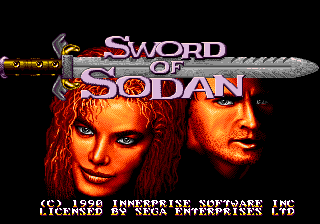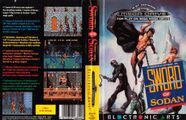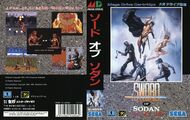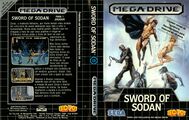Difference between revisions of "Sword of Sodan"
From Sega Retro
Scarred Sun (talk | contribs) m (Text replacement - "Physical Scans" to "Physical scans") |
AllisonKidd (talk | contribs) |
||
| Line 16: | Line 16: | ||
| md_rrp_jp=6,000 | | md_rrp_jp=6,000 | ||
| md_code_jp=G-4056 | | md_code_jp=G-4056 | ||
| − | | md_date_br= | + | | md_date_br=1992-04 {{fileref|Supergame BR 09.pdf|page=45}} |
}} | }} | ||
| genre=Action | | genre=Action | ||
| Line 22: | Line 22: | ||
'''''Sword of Sodan''''' (ソード・オブ・ソダン) is a 1988 beat-'em-up for the Commodore Amiga by [[Discovery Software International]]. [[Innerprise]] ported it to the [[Sega Mega Drive]] for [[Electronic Arts]] in 1990. | '''''Sword of Sodan''''' (ソード・オブ・ソダン) is a 1988 beat-'em-up for the Commodore Amiga by [[Discovery Software International]]. [[Innerprise]] ported it to the [[Sega Mega Drive]] for [[Electronic Arts]] in 1990. | ||
| − | The [[Sega Mega Drive]]port uses the same theme and story, but both gameplay and graphics have been strongly altered. | + | The [[Sega Mega Drive]] port uses the same theme and story, but both gameplay and graphics have been strongly altered. |
The player has to choose between a male and female sword fighter at the start of the game. | The player has to choose between a male and female sword fighter at the start of the game. | ||
| Line 28: | Line 28: | ||
==Gameplay== | ==Gameplay== | ||
| − | The game is a side-scrolling beat-'em-up, with gore elements, long before [[Mortal Kombat]] further popularized them. | + | The game is a side-scrolling beat-'em-up, with gore elements, long before ''[[Mortal Kombat]]'' further popularized them. |
{{B}} jumps, holding down the button results in higher jumps. It's also used to turn around by pushing together with {{left}} or {{right}}. {{down}} ducks. {{C}} swings the character's sword. Combined with {{up}}, {{right}} and {{down}} other attacks are available. | {{B}} jumps, holding down the button results in higher jumps. It's also used to turn around by pushing together with {{left}} or {{right}}. {{down}} ducks. {{C}} swings the character's sword. Combined with {{up}}, {{right}} and {{down}} other attacks are available. | ||
Attack strength depends on the current "HIT" value displayed on top of the screen. It decreases when losing a life. | Attack strength depends on the current "HIT" value displayed on top of the screen. It decreases when losing a life. | ||
{{A}} is used to drink potions, but these have to be selected in the pause menu first. Potions can be combined for various effects. | {{A}} is used to drink potions, but these have to be selected in the pause menu first. Potions can be combined for various effects. | ||
| − | Enemy health is shown underneath the | + | Enemy health is shown underneath the corresponding enemy. Enemies randomly drop potions. |
Areas are usually cleared by defeating all enemies and exiting by going to the right. | Areas are usually cleared by defeating all enemies and exiting by going to the right. | ||
| − | Attacks have very specific hit zones, e.g. the first enemies you encounter, spear | + | Attacks have very specific hit zones, e.g. the first enemies you encounter, spear wielding guards, can not attack at point blank range, but their spear strikes outclass the player character. As a consequence, for safe combating on has to jump in and attack at point blank, or stay out of their range and counterattack. As another example, giants can only be hurt by using high attacks. |
On normal difficulty, it's vital to stock the correct potions, e.g. giants have very random hit detection and their attacks can't be evaded up close, so it's useful to have invincibility in stock, or at least boost weapon strength | On normal difficulty, it's vital to stock the correct potions, e.g. giants have very random hit detection and their attacks can't be evaded up close, so it's useful to have invincibility in stock, or at least boost weapon strength | ||
===Potions=== | ===Potions=== | ||
| − | *red = increases attack | + | *red = increases attack strength |
*orange = defeats the closest enemy | *orange = defeats the closest enemy | ||
*blue = restores health | *blue = restores health | ||
| Line 63: | Line 63: | ||
*Stage layouts were modified | *Stage layouts were modified | ||
*The wood area is missing | *The wood area is missing | ||
| − | *The | + | *The ostrich-like creature in the dungeon stage is missing |
==Trivia== | ==Trivia== | ||
| Line 73: | Line 73: | ||
| cvg=57 | | cvg=57 | ||
| cvg_source={{num|112|page=72|pdf=CVG UK 112.pdf}} | | cvg_source={{num|112|page=72|pdf=CVG UK 112.pdf}} | ||
| + | | cvgit=57 | ||
| + | | cvgit_source={{num|4|page=88|pdf=CVG IT 04.pdf}} | ||
| gamepro=88 | | gamepro=88 | ||
| gamepro_source={{num|20|page=60|pdf=GamePro US 020.pdf|pdfpage=76}} | | gamepro_source={{num|20|page=60|pdf=GamePro US 020.pdf|pdfpage=76}} | ||
| Line 78: | Line 80: | ||
| joystick_source={{num|13|page=113}} | | joystick_source={{num|13|page=113}} | ||
| mdag=40 | | mdag=40 | ||
| − | | mdag_source={{num|3|page=79}} | + | | mdag_source={{num|3|page=79|pdf=MDAG UK 03.pdf}} |
| megatech=55 | | megatech=55 | ||
| − | | megatech_source={{num|1|page=81|pdf=MegaTech UK 01.pdf | + | | megatech_source={{num|1|page=81|pdf=MegaTech UK 01.pdf}} |
| mm=59 | | mm=59 | ||
| mm_source={{num|5|page=78/79|pdf=MeanMachines UK 05.pdf|pdfpage=78}} | | mm_source={{num|5|page=78/79|pdf=MeanMachines UK 05.pdf|pdfpage=78}} | ||
| Line 106: | Line 108: | ||
| region=JP | | region=JP | ||
| cover=SoS MD JP Box.jpg | | cover=SoS MD JP Box.jpg | ||
| − | | cart= | + | | cart=SwordofSodan MD JP Cart.jpg |
| − | | carttop= | + | | carttop=SwordofSodan MD JP CartTop.jpg |
}}{{Scanbox | }}{{Scanbox | ||
| console=Mega Drive | | console=Mega Drive | ||
Revision as of 23:33, 24 March 2016
This short article is in need of work. You can help Sega Retro by adding to it.
| Sword of Sodan | |||||
|---|---|---|---|---|---|
| System(s): Sega Mega Drive | |||||
| Publisher: Electronic Arts (US/EU), Sega (JP) | |||||
| Developer: Discovery Software International, Innerprise | |||||
| Genre: Action | |||||
|
Sword of Sodan (ソード・オブ・ソダン) is a 1988 beat-'em-up for the Commodore Amiga by Discovery Software International. Innerprise ported it to the Sega Mega Drive for Electronic Arts in 1990.
The Sega Mega Drive port uses the same theme and story, but both gameplay and graphics have been strongly altered.
The player has to choose between a male and female sword fighter at the start of the game. The option menu allows to modify the difficulty level (Normal or Easy) and the number of lives.
Gameplay
The game is a side-scrolling beat-'em-up, with gore elements, long before Mortal Kombat further popularized them.
![]() jumps, holding down the button results in higher jumps. It's also used to turn around by pushing together with
jumps, holding down the button results in higher jumps. It's also used to turn around by pushing together with ![]() or
or ![]() .
. ![]() ducks.
ducks. ![]() swings the character's sword. Combined with
swings the character's sword. Combined with ![]() ,
, ![]() and
and ![]() other attacks are available.
Attack strength depends on the current "HIT" value displayed on top of the screen. It decreases when losing a life.
other attacks are available.
Attack strength depends on the current "HIT" value displayed on top of the screen. It decreases when losing a life.
![]() is used to drink potions, but these have to be selected in the pause menu first. Potions can be combined for various effects.
is used to drink potions, but these have to be selected in the pause menu first. Potions can be combined for various effects.
Enemy health is shown underneath the corresponding enemy. Enemies randomly drop potions.
Areas are usually cleared by defeating all enemies and exiting by going to the right.
Attacks have very specific hit zones, e.g. the first enemies you encounter, spear wielding guards, can not attack at point blank range, but their spear strikes outclass the player character. As a consequence, for safe combating on has to jump in and attack at point blank, or stay out of their range and counterattack. As another example, giants can only be hurt by using high attacks.
On normal difficulty, it's vital to stock the correct potions, e.g. giants have very random hit detection and their attacks can't be evaded up close, so it's useful to have invincibility in stock, or at least boost weapon strength
Potions
- red = increases attack strength
- orange = defeats the closest enemy
- blue = restores health
- transparent = no effect
- red + transparent = extra life
- orange + transparent = flaming brand (stronger sword with fire effect)
- blue + transparent = temporal invincibility
- red + orange = flaming brand (stronger sword with fire effect)
- transparent x 4 = skip stage
Other combinations either have no effect or are poisenous to the player.
Version differences
(Compared to the Amiga version)
- Most graphics were redrawn and/or scaled down
- Swordplay is different
- Stage layouts were modified
- The wood area is missing
- The ostrich-like creature in the dungeon stage is missing
Trivia
The game features an undocumented level skip in stage 5 (stage with invisible pits). Don't fall down the first and second pit, but deliberately fall down the third pit. This will skip directly to stage 6.
Physical scans
| ExpandSega Retro Average |
|---|
| 48 | |
|---|---|
| Based on 27 reviews | |
References
- ↑ File:CVG UK 112.pdf, page 72
- ↑ File:CVG IT 04.pdf, page 88
- ↑ Jump up to: 3.0 3.1 File:GamePro US 020.pdf, page 76 Cite error: Invalid
<ref>tag; name ":File:GamePro US 020.pdf_p76" defined multiple times with different content - ↑ Jump up to: 4.0 4.1 File:MDAG UK 03.pdf, page 79 Cite error: Invalid
<ref>tag; name ":File:MDAG UK 03.pdf_p79" defined multiple times with different content - ↑ Jump up to: 5.0 5.1 File:MegaTech UK 01.pdf, page 81 Cite error: Invalid
<ref>tag; name ":File:MegaTech UK 01.pdf_p81" defined multiple times with different content - ↑ Jump up to: 6.0 6.1 File:MeanMachines UK 05.pdf, page 78 Cite error: Invalid
<ref>tag; name ":File:MeanMachines UK 05.pdf_p78" defined multiple times with different content - ↑ Jump up to: 7.0 7.1 File:Raze UK 06.pdf, page 48 Cite error: Invalid
<ref>tag; name ":File:Raze UK 06.pdf_p48" defined multiple times with different content - ↑ 1700 igr dlya Sega, "" (RU; 2001-xx-xx), page 233
- ↑ Aktueller Software Markt, "März 1991" (DE; 1991-02-22), page 116
- ↑ Beep! MegaDrive, "October 1991" (JP; 1991-09-07), page 36
- ↑ Console XS, "June/July 1992" (UK; 1992-04-23), page 135
- ↑ Cool Gamer, "9" (RU; 2002-10-13), page 215
- ↑ Computer & Video Games, "March 1991" (UK; 1991-02-16), page 88
- ↑ Mean Machines: The Essential Sega Guide, "" (UK; 1993-11-18), page 103
- ↑ Famitsu, "1991-10-18" (JP; 1991-10-04), page 1
- ↑ Génération 4, "Février 1991" (FR; 1991-xx-xx), page 101
- ↑ Hippon Super, "November 1991" (JP; 1991-10-04), page 91
- ↑ Joystick, "Février 1991" (FR; 1991-0x-xx), page 113
- ↑ Sega Mega Drive Advanced Gaming, "January 1993" (UK; 199x-xx-xx), page 94
- ↑ Mega Drive Fan, "January 1992" (JP; 1991-12-07), page 101
- ↑ Mega Play, "February 1991" (US; 199x-xx-xx), page 45
- ↑ Mean Machines Sega, "October 1992" (UK; 1992-09-xx), page 142
- ↑ Power Play, "4/91" (DE; 1991-03-15), page 135
- ↑ Sega Power, "October 1991" (UK; 1991-09-05), page 54
- ↑ Sega Power, "March 1991" (UK; 1991-02-07), page 18
- ↑ Sega Pro, "April 1993" (UK; 1993-03-11), page 68
- ↑ Sega Saturn Magazine, "September 1995" (JP; 1995-08-08), page 87
- ↑ Tricks 16 bit, "Tricks Sega Gold 800 igr" (RU; 1998-03-20), page 192
- ↑ VideoGames & Computer Entertainment, "March 1991" (US; 1991-0x-xx), page 44
- Pages with reference errors
- Stubs
- No players field
- Use romtable template
- All games
- Old-style rating (cvg)
- Use magref
- Old-style rating (cvgit)
- Old-style rating (gamepro)
- Old-style rating (joystick)
- Rating without PDF source
- Old-style rating (mdag)
- Old-style rating (megatech)
- Old-style rating (mm)
- Old-style rating (raze)
- Old-style rating (segapower)
- Old-style rating (segapro)
- Update ratings template
- 11 old ratings




